
Wine Culture and Information since 2002 - Volume 22
 Wine Culture and Information since 2002 - Volume 22 |
|
Franciacorta, Champagne and TalentoThree classic examples of quality Italian and French vintage bubbles, reveals their secrets in the frothing glasses of our comparative tasting |
|
Talking about bubbles - in particular about noble bubbles produced with the classic method - the association with great quality wines is obviously foregone. The charm of bubbles - impossible to deny - takes its origin from the long and prestigious tradition of Champagne, when the wines produced in that area became the symbol of nobility, of a refined and elegant life style, as well as representing an expensive product for the elite. By following the French fame, other countries began the production of wines by means of classic method in the hope of getting the same success. Italy, Spain, United States of America, South Africa and Australia are just few examples of countries in which the production of classic method sparkling wines has a relevant importance. The quality of sparkling wines produced in these countries increased to a level as to compete - frequently with the same opportunities - with the most celebrated and renowned wines of Champagne. Despite the production techniques and the grapes used are more or less the same as in Champagne, it is appropriate to remember every area gives its wines its personal character impossible to find elsewhere. Despite this fundamental and important consideration, many wine lovers keep on arguing on which sparkling wine is better, without considering each one of them is unique in its genre. No matter the region of origin, the grapes mainly used for the production of classic method sparkling wines are Chardonnay and Pinot Noir, to which are sometimes added grapes belonging to local traditions as well as other grapes capable of giving the wine its typical character. The same can be said for the production system that, despite it is defined in many ways in the respective disciplinary and according to appropriate adaptations, they are all based on the so called classic method - that is the method of the refermentation in bottle - with variable aging time and that can also be of tens of years.
|
|
The wines selected for this month's comparative tasting are all produced according the method of refermentation in bottle. We will compare three vintage sparkling wines - worth representatives of the respective categories - of which we will try to understand analogies and differences. We decided to compare the king of French bubbles - Champagne - with two interesting and excellent Italian wines - renowned worldwide since many years for the quality they expressed - produced in the northern part of the country: Franciacorta and Talento. In all the three wines are present two of the most classic grapes - in different percentages - used for the production of sparkling wines: Chardonnay and Pinot Noir. Whereas Chardonnay is generally responsible for class, finesse and elegance of wine, Pinot Noir is in charge to give structure, as well as giving its typical organoleptic qualities.
According to an organoleptic point of view, the three selected wines offer interesting characteristics of comparison as well as analogies. The Champagne selected for our comparative tasting is Drappier's Grande Sendrée Brut, produced with 55% of Pinot Noir and 45% of Chardonnay, belonging to the millésime category. As for Franciacorta, we selected Ca' del Bosco's Cuvée Annamaria Clementi, produced with 55% of Chardonnay, 25% of Pinot Blanc and 20% Pinot Noir fermented and aged in barrique for 7 months, then it follows a refermentation and aging in bottle for 5 years and 8 months. The last wine selected for our tasting is Dorigati's Trento Talento Brut Riserva Methius, produced with 60% Chardonnay - of which a small part fermented in barrique - and 40% Pinot Noir, the wine is refermented and aged in bottle for about five years. The selected vintages will be, in all the three cases, the most recent ones. Serving temperature - because of the fact they are vintage wines and therefore it should be better to favor the development of complex aromas - will be of 12°C (53.6°F). As for glasses, the ideal one is represented by the so called classic method sparkling wine technical glass - generally adopted and proposed by the many production consortiums - however it will also be possible to use the classic ISO tasting glass with excellent results.
|
||||||||
|
As the wines have been poured in the respective glasses, we will notice all of them will form an abundant froth that will tend to dissolve in few seconds, just like we would expect from any quality classic method sparkling wine. The next characteristic we are going to examine is perlage, that is the quality, quantity and development of bubbles. On this regard it is appropriate to remember the analysis of perlage in sparkling wines represents a quality factor: the finer and more persistent the bubbles, the better the production techniques. In general terms, bubbles in classic method sparkling wines are finer than the ones produced with the Charmat method, thanks to the production method which allows a slower and more efficient solubilization of carbon dioxide in wine. For this reason, in quality classic method sparkling wines, perlage must always be fine and persistent, with bubbles having a diameter lesser than one millimeter and that will develop for many minutes in a continuous and copious chain moving upwards the surface. By observing the development of the perlage in our wines, we will notice some similarities: quick chains of very fine bubbles moving upwards and then moving towards the edge of the glass. After having observed the perlage, we will continue our evaluation by examining the color of the three wines. The first wine we will examine is Talento Methius. It will be observed an intense straw yellow color - and by tilting the glass over a white surface - there will be noticed straw yellow nuances in the edge of the liquid mass near the opening. Let's now evaluate Franciacorta Annamaria Clementi: its color will be pale golden yellow with evident nuances of straw yellow. We will notice the color is more intense than Methius: it is good to remember Cuvée Annamaria Clementi is aged for a longer period of time. Let's now observe the color of Drappier's Champagne Grande Sendrée. In this wine the color will be more intense than the other two, it will be noticed a brilliant golden yellow color and nuances of golden yellow, absolutely coherent with its type and the long aging in bottle. Finally, the three glasses will be observed side to side: it will be noticed how the color gets a more intense hue according to the aging time in bottle; paler in Methius, deeper in Franciacorta Annamaria Clementi and in Champagne Grande Sendrée.
|
|
The analysis of aromas certainly is one of the most interesting and amazing aspects of vintage classic method sparkling wines. For this reason it is preferable to taste the three wines at a temperature used for young whites, 11°-12°C (52°-54°F). A lower temperature - there is even who serve these wines at 6°C (42°F), destroying in a moment the patient work of time - would favor the persistence and development of perlage that, despite it is pleasing to see, it will never be as amazing as the complex aromas these wines are capable to express. For the same reason, it would be appropriate to avoid a tight flûte glass in favor of a larger one. The first wine we will examine is Dorigati's Talento Methius. By holding the glass still, we will evaluate the opening aromas: there will be perceived aromas of banana and bread crust. Then - after having swirled the glass - a second smell will be done which will allow the perceiving of intense and pleasing aromas of acacia, pineapple, butter, hawthorn, kiwi, yeast, apple, honey, grapefruit, hazelnut, plum, chamomile and, finally, a pleasing hint of vanilla, the prove of Chardonnay's aging in wood. Let's now evaluate Ca' del Bosco's Franciacorta Cuvée Annamaria Clementi aromas. The opening - done without moving the glass - gives intense aromas of bread crust, yeast, banana and acacia. Let's now swirl the glass as to allow a proper wine oxygenation. There will be perceived intense and refined aromas of apricot, pineapple, apple, pear, litchi, grapefruit as well as a pleasing hint of hazelnut. By continuing the olfactory analysis, there will be noticed more complex aromas - because of the effects of the long aging of wine in bottle on its yeast - of butter and honey, as well as a pleasing aroma of vanilla, effect of the fermentation and aging of base wine in barrique for 7 months. This olfactory impact - for many aspects similar to the excellent Methius - is typical in classic method sparkling wines aged for some years in bottle, where complex aromas wonderfully get married with aromas of fruit and flowers typical of the grapes used for the production. The third and last wine of which we will examine aromas is Drappier's Champagne Grande Sendrée Brut. By holding the glass still, there will be perceived intense and pleasing opening aromas such as bread crust, honey and yeast. Let's now swirl the glass in order to favor a proper wine oxygenation, and then let's evaluate aromas. There will be perceived aromas of fruit such as banana, pineapple, apple, litchi and grapefruit as well as a pleasing aroma of orange peel. Moreover, there will be perceived aromas of brioche, butter and praline, as well as a pleasing hint of flint. Pay your attention on the complexity of aromas and their evolution in the glass: a distinctive sign - just like in the other wines - of the patient aging of wine in the bottle on its yeast. The olfactory analysis of the three wines allows the understanding of interesting common factors: in all the three cases are found pleasing aromas of bread crust and yeast, typical in classic method sparkling wines aged for some years in bottle. Even the aromatic sequence of fruit and flowers is similar - although keeping in each case their evident personality - particularly thanks to Chardonnay grape, present in all the three wines.
|
||||
|
The gustatory analysis of the three wines will allow the understanding of some common aspects, typical in classic method sparkling wines aged for some years in bottle. The first wine we will examine is Dorigati's Talento Methius. This excellent Talento will show a balanced crispness and effervescence, intense flavors and - in particular - a very good correspondence of flavors to the aromas perceived to the nose. In particular, it will be noticed the pleasing smoothness of the wine as well as flavors of banana, grapefruit and apple. Finally, it will be examined the alcohol impact of the wine and how it is perfectly balanced by the pleasing crispness. Let's now evaluate Ca' del Bosco's Franciacorta Cuvée Annamaria Clementi. Even in this case it will be perceived a pleasing crispness and a good effervescence, as well as the excellent correspondence of flavors to the aromas perceived to the nose. Even in this wine the smoothness is a pretty evident gustatory quality - thanks to the long aging in bottle - and that gives the wine a remarkable elegance. The long aging in bottle will also give this wine a fuller structure, also supported by the presence of Pinot Noir grape. In the mouth will be perceived - clean and intense - flavors of banana, litchi, apple and pear. Let's now examine Drappier's Champagne Grande Sendrée Brut. Even in this case the attack is clearly crisp and effervescent - well balanced by alcohol - with flavors very correspondence to the aromas perceived to the nose. In this wine will be noticed - in particular - the evident and pleasing smoothness as well as a good structure, in this case fuller than the other two wines. It is good to remember this Champagne is produced with 55% of Pinot Noir which - together with the long aging in bottle - will give the wine a fuller structure. It will also be noticed how in all the three wines - besides the usual crispness and effervescence - is present a pleasing and elegant roundness, generally not found in classic method sparkling wines aged in bottle for few tens of months.
|
|
The final sensations of the three sparkling wines, have in common the long taste-olfactory persistence as to confirm their excellent quality. The finish of Methius leaves in the mouth long flavors of banana, honey, grapefruit, apple and hazelnut, confirming its pleasing and interesting complexity. The finish of Franciacorta Annamaria Clementi will leave long flavors of banana, litchi, pineapple, honey, pear, apple and grapefruit, even in this case, very elegant and with interesting organoleptic complexity. Champagne Grande Sendrée will leave in the mouth long flavors of honey, banana, grapefruit and brioche, all being of remarkable elegance. The evaluation of these three classic methods will allow the understanding of the organoleptic contribution of Chardonnay in all the three wines - in particular the aromatic similarities of fruit and flowers - as well as the contribution of Pinot Noir in structure, also supported by the long aging. Despite analogies - classic method and grapes - it will be noticed how each wine will be different from the others thanks - in particular - to the respective production areas capable of giving the wines an absolutely unique character.
|
Wines of the Month |
|
|
|
Score legend Prices are to be considered as indicative. Prices may vary according to the country or the shop where wines are bought |
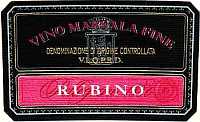
|
|
Marsala Fine Rubino |
|
| Carlo Pellegrino (Italy) | |
| Grapes: Nero d'Avola | |
| Price: € 12.00 | Score: |
| This Marsala shows an intense ruby red color and nuances of garnet red, little transparency. The nose denotes intense, clean, pleasing and refined aromas of black cherry and blackberry followed by aromas blueberry, plum, violet, vanilla, cocoa, licorice and cinnamon. The mouth has good correspondence to the nose, a sweet, hot and slightly tannic attack, pleasing roundness, however balanced, good body, intense flavors, good tannins. The finish is persistent with flavors of blackberry, black cherry and blueberry. This Marsala ages for more than 12 months in oak casks. | |
| Food Match: Chocolate tarts, Fruit jam tarts | |
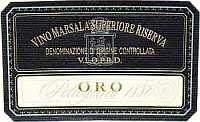
|
|
Marsala Superiore Riserva Oro |
|
| Carlo Pellegrino (Italy) | |
| Grapes: Grillo (70%), Catarratto (30%) | |
| Price: € 15.00 | Score: |
| This Marsala shows a brilliant amber yellow color and nuances of amber yellow, transparent. The nose denotes intense, clean, pleasing and refined aromas that start with hints of almond and dried fig followed by aromas of date, apricot jam, orange marmalade, honey, vanilla, ethereal and caramel. The mouth has good correspondence to the nose, a sweet and hot attack, however balanced, pleasing smoothness, full body, intense flavors. The finish is persistent with flavors of dried fig, honey, almond and date. This Marsala ages for more than 4 years in oak casks. | |
| Food Match: Almond and dried fruit tarts, Hard and piquant cheese | |
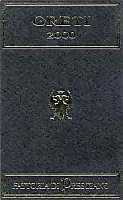
|
|
Greti 1999 |
|
| Fattoria di Presciano (Italy) | |
| Grapes: Sangiovese | |
| Price: € 15.00 | Score: |
| This wine shows a brilliant ruby red color and nuances of garnet red, moderate transparency. The nose reveals intense, clean, pleasing and refined aromas which start with hints of plum and black cherry followed by aromas of blackberry jam, blueberry, dried violet, licorice, tobacco, menthol, cocoa and vanilla. The mouth has good correspondence to the nose, a slightly tannic attack and pleasing smoothness, however balanced by alcohol, good body, intense flavors, good tannins. The finish is persistent with flavors of black cherry, plum and blueberry. Greti ages for 12 months in barrique followed by 8 months of aging in bottle. | |
| Food Match: Roasted meat, Stewed and braised meat, Hard cheese | |
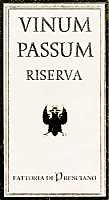
|
|
Colli dell'Etruria Centrale Vin Santo Riserva Vinum Passum 1998 |
|
| Fattoria di Presciano (Italy) | |
| Grapes: Trebbiano Toscano (80%), Malvasia Bianca (15%), Sangiovese (5%) | |
| Price: € 20.50 - 500ml | Score: |
| This wine shows an intense amber yellow color and nuances of amber yellow, transparent. The nose denotes intense, clean, pleasing and refined aromas which start with hints of almond, fig jam and prune followed by aromas of raisin, caramel, honey, peach jam, orange peel, enamel and vanilla. The mouth has good correspondence to the nose, a sweet and smooth attack, however well balanced by alcohol, full body, intense flavors, agreeable. The finish is persistent with flavors of almond, fig jam and caramel. This Vin Santo ages for 4 years in small barrels. | |
| Food Match: Hard and piquant cheese, Almond and dried fruit tarts | |
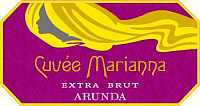
|
|
Alto Adige Talento Extra Brut Cuvée Marianna |
|
| Arunda Vivaldi (Italy) | |
| Grapes: Chardonnay (80%), Pinot Noir (20%) | |
| Price: € 15.50 | Score: |
| This Talento shows a brilliant golden yellow color and nuances of golden yellow, very transparent, good effervescence, fine and persistent perlage. The nose reveals intense, clean, pleasing and refined aromas which start with hints of bread crust, banana and hazelnut followed by aromas of vanilla, hawthorn, grapefruit, butter, jasmine, honey, apple and plum. The mouth has good correspondence to the nose, a crisp and effervescent attack, good smoothness, however balanced, good body, intense flavors. The finish is persistent with flavors of hazelnut, plum and grapefruit. The Chardonnay ages in barrique. This Talento ages on its lees in bottle for 60 months. | |
| Food Match: Roasted fish, Stuffed pasta with mushrooms, Roasted white meat, Stewed fish | |
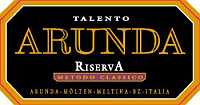
|
|
Alto Adige Talento Extra Brut Riserva Arunda 1998 |
|
| Arunda Vivaldi (Italy) | |
| Grapes: Chardonnay (60%), Pinot Noir (40%) | |
| Price: € 15.50 | Score: |
| This Talento shows a pale golden yellow color and nuances of straw yellow, very transparent, good effervescence, fine and persistent perlage. The nose reveals intense, clean, pleasing and refined aromas which start with hints of bread crust, honey and hazelnut followed by aromas of banana, butter, pineapple, hawthorn, yeast, apple, grapefruit, praline and plum. The mouth has good correspondence to the nose, a crisp and effervescent attack, good roundness, however balances, good body, intense flavors, agreeable. The finish is persistent with flavors of banana, plum and grapefruit. This Talento Reserve ages on its lees in bottle for 70 months. | |
| Food Match: Roasted fish, Fish and mushrooms soups, Braised fish, Roasted white meat | |
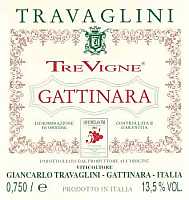
|
|
Gattinara Tre Vigne 1999 |
|
| Travaglini (Italy) | |
| Grapes: Nebbiolo | |
| Price: € 16.50 | Score: |
| This wine shows a brilliant ruby red color and nuances of garnet red, moderate transparency. The nose reveals intense, clean, pleasing, refined and elegant aromas which start with hints of cherry, violet and plum followed by aromas of blueberry, rose, coffee, cinnamon, vanilla, licorice, tobacco, menthol, leather and chocolate. The mouth has good correspondence to the nose, a pleasing crisp attack, slightly tannic and good roundness, however balanced by alcohol, full body, intense flavors, good tannins. The finish is persistent with flavors of cherry and plum. A well made wine. This Gattinara ages for 10-12 months in barrique. | |
| Food Match: Game, Roasted meat, Braised and stewed meat, Hard cheese | |
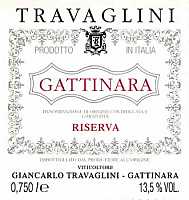
|
|
Gattinara Riserva 1999 |
|
| Travaglini (Italy) | |
| Grapes: Nebbiolo | |
| Price: € 16.00 | Score: |
| This Gattinara shows a brilliant ruby red color and nuances of garnet red, moderate transparency. The nose reveals intense, clean, pleasing, refined and elegant aromas which start with hints of cherry, geranium and violet followed by aromas of raspberry, plum, rose, vanilla, licorice, tobacco, cinnamon, menthol, leather, cocoa and thyme. The mouth has good correspondence to the nose, a slightly tannic attack, pleasing crispness, good roundness, however well balanced by alcohol, full body, intense flavors, good tannins. The finish is very persistent with long flavors of cherry, raspberry and plum. A well made wine. This Gattinara ages for at least 3 years in cask followed by 12 months of aging in bottle. | |
| Food Match: Game, Roasted meat, Braised and stewed meat, Hard cheese | |
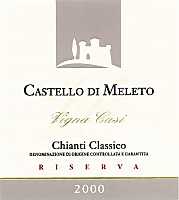
|
|
Chianti Classico Riserva Vigna Casi 2000 |
|
| Castello di Meleto (Italy) | |
| Grapes: Sangiovese (85%), Colorino (5%), Merlot (10%) | |
| Price: € 14.00 | Score: |
| This Chianti shows an intense ruby red color and nuances of garnet red, little transparency. The nose reveals intense, clean, pleasing, refined and elegant aromas which start with hints of black cherry, plum and blackberry followed by aromas of blueberry, violet, licorice, vanilla, tobacco, mace, cocoa and menthol. The mouth has good correspondence to the nose, a slightly tannic attack and pleasing roundness, however balanced by alcohol, good body, intense flavors, good tannins, agreeable. The finish is persistent with flavors of black cherry, plum and blackberry. A well made wine. This Chianti Reserve ages for 18 months in cask followed by 6 months of aging in bottle. | |
| Food Match: Roasted meat, Braised and stewed meat, Hard cheese | |
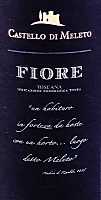
|
|
Fiore 2000 |
|
| Castello di Meleto (Italy) | |
| Grapes: Sangiovese (75%), Merlot (25%) | |
| Price: € 18.00 | Score: |
| The wine shows an intense ruby red color and nuances of garnet red, little transparency. The nose denotes intense, clean, pleasing, refined and elegant aromas that start with hints of black cherry and plum followed by aromas of blackberry, violet, licorice, vanilla, tobacco, cinnamon, chocolate, black pepper and eucalyptus. The mouth has good correspondence to the nose, a slightly tannic attack and good roundness, however well balanced by alcohol, full body, intense flavors, good tannins. The finish is persistent with flavors of black cherry, plum and blackberry. A well made wine. Fiore ages for 12 months in cask followed by 6 months of aging in bottle. | |
| Food Match: Game, Roasted meat, Stewed and braised meat, Hard cheese | |
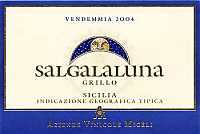
|
|
Salgalaluna 2004 |
|
| Miceli (Italy) | |
| Grapes: Grillo | |
| Price: € 3.50 | Score: |
| The wine shows an intense greenish yellow color and nuances of greenish yellow, very transparent. The nose denotes intense, clean, pleasing and refined aromas which start with hints of pear, peach and hawthorn followed by aromas of pineapple, litchi, almond, apple and plum. The mouth has good correspondence to the nose, a crisp attack and however balanced by alcohol, good body, intense flavors, agreeable. The finish is persistent with flavors of pear, peach and almond. This wine ages for 3-6 months in steel tanks. | |
| Food Match: Fried fish, Pasta and risotto with fish and crustaceans | |
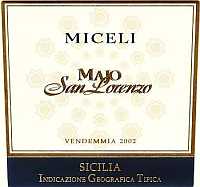
|
|
Majo San Lorenzo 2001 |
|
| Miceli (Italy) | |
| Grapes: Cabernet Sauvignon (50%), Merlot (50%) | |
| Price: € 18.00 | Score: |
| This wine shows an intense ruby red color and nuances of garnet red, little transparent. The nose denotes intense, clean, pleasing and refined aromas which start with hints of black cherry, plum and blueberry followed by aromas of blackberry, vanilla, tobacco, licorice, cocoa, menthol and lavender. The mouth has good correspondence to the nose, a slightly tannic attack, however balanced by alcohol, good body, intense flavors, good tannins, agreeable. The finish is persistent with flavors of black cherry, plum and blueberry. This wine ages for 12 months in barrique followed by 6 months of aging in steel tanks. | |
| Food Match: Roasted meat, Broiled meat and barbecue, Stewed meat, Hard cheese | |
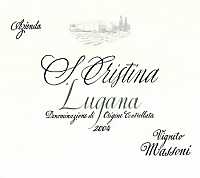
|
|
Lugana Santa Cristina Vigneto Massoni 2004 |
|
| Zenato (Italy) | |
| Grapes: Trebbiano di Lugana | |
| Price: € 15.00 | Score: |
| This wine shows a brilliant greenish yellow color and nuances of greenish yellow, very transparent. The nose denotes intense, clean, pleasing and refined aromas that start with hints of pineapple, pear and peach followed by aromas of citrus fruits, hawthorn, broom, litchi and apple. The mouth has good correspondence to the nose, a crisp attack and however balanced by alcohol, good body, intense flavors, agreeable. The finish is persistent with flavors of pear, pineapple and peach. This Lugana ages for 4-5 months in steel tanks followed by 2-3 months of aging in bottle. | |
| Food Match: Pasta and risotto with fish and crustaceans, Broiled fish | |
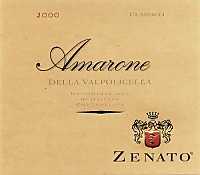
|
|
Amarone della Valpolicella Classico 2000 |
|
| Zenato (Italy) | |
| Grapes: Corvina (80%), Rondinella (10%), Sangiovese (10%) | |
| Price: € 40.00 | Score: |
| The wine shows an intense ruby red color and nuances of garnet red, little transparency. The nose denotes intense, clean, pleasing, refined and elegant aromas which start with hints of blackberry, plum and black cherry followed by aromas of violet, tobacco, licorice, pink pepper, vanilla, cinnamon and cocoa. The mouth has good correspondence to the nose, a tannic attack and however balanced by alcohol, full body, intense flavors, good tannins. The finish is persistent with flavors of blackberry, plum and black cherry. A well made wine. This Amarone ages for 18-24 months in cask followed by 12 months of aging in bottle. | |
| Food Match: Game, Stewed and braised meat, Roasted meat, Hard cheese | |
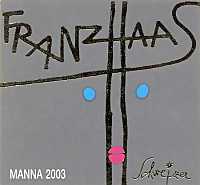
|
|
Manna 2003 |
|
| Franz Haas (Italy) | |
| Grapes: Riesling, Gewürztraminer, Chardonnay, Sauvignon Blanc | |
| Price: € 13.30 | Score: |
| The wine shows a brilliant golden yellow color and nuances of golden yellow, very transparent. The nose denotes intense, clean, pleasing, refined and elegant aromas which start with hints of pear, banana and peach followed by aromas of pineapple, litchi, hawthorn, broom, plum, apple, elder and vanilla. The mouth has good correspondence to the nose, a crisp attack and good smoothness, however balanced by alcohol, good body, intense flavors, agreeable. The finish is persistent with flavors of peach, pear, plum and banana. A well made wine. The Gewürztraminer is from late vintage and Chardonnay ferments in cask. Manna ages for 5-8 months on its lees followed by 4-7 months of aging in bottle. | |
| Food Match: Vegetables soups, Pasta and risotto with vegetables and fish, Sauteed fish and white meat | |
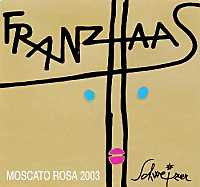
|
|
Alto Adige Moscato Rosa 2003 |
|
| Franz Haas (Italy) | |
| Grapes: Moscato Rosa | |
| Price: € 16.70 - 375ml | Score: |
| The wine shows a brilliant ruby red color and nuances of ruby red, moderate transparency. The nose denotes intense, clean, pleasing, refined and elegant aromas which start with hints of grape, rose and strawberry followed by aromas of geranium, cherry, raspberry, violet, cinnamon, clove and pink pepper. The mouth has good correspondence to the nose, a sweet attack and pleasing crispness, good roundness, however balanced by alcohol, good body, intense flavors, agreeable. The finish is persistent with flavors of cherry, strawberry and raspberry. A well made wine. This Moscato Rosa ages in steel tanks and ages for at least 6 months in bottle. | |
| Food Match: Fruit desserts | |
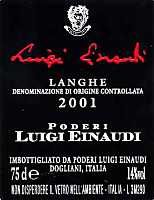
|
|
Langhe Rosso Luigi Einaudi 2001 |
|
| Poderi Luigi Einaudi (Italy) | |
| Grapes: Cabernet Sauvignon, Merlot (60%), Nebbiolo, Barbera (40%) | |
| Price: € 25.00 | Score: |
| The wine shows an intense ruby red color and nuances of ruby red, little transparency. The nose reveals intense, clean, pleasing and refined aromas which start with hints of black cherry, plum and blueberry followed by aromas of violet, blackberry, vanilla, tobacco, cyclamen, licorice, carob and menthol. The mouth has good correspondence to the nose, a tannic attack and however balanced by alcohol, full body, intense flavors, good tannins, agreeable. The finish is persistent with flavors of black cherry, plum and blackberry. A well made wine. This Langhe Rosso ages for 18 months in barrique followed by 6 months of aging in bottle. | |
| Food Match: Game, Roasted meat, Braised and stewed meat, Hard cheese | |
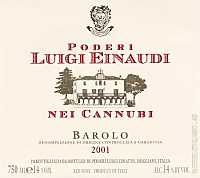
|
|
Barolo Cannubi 2001 |
|
| Poderi Luigi Einaudi (Italy) | |
| Grapes: Nebbiolo | |
| Price: € 50.00 | Score: |
| This Barolo shows a brilliant ruby red color and nuances of garnet red, moderate transparency. The nose reveals intense, clean, pleasing and refined aromas which start with hints of cherry and plum followed by aromas of blueberry, violet, vanilla, licorice, tobacco, mace, pink pepper and menthol. The mouth has good correspondence to the nose, a tannic attack and pleasing crispness, however balanced by alcohol, full body, intense flavors, good tannins. The finish is persistent with flavors of cherry, plum and blueberry. A well made wine. This Barolo ages for 3 years of which 2 years in barrique. | |
| Food Match: Game, Roasted meat, Braised and stewed meat with mushrooms, Hard cheese | |
Carlo Pellegrino's Marsala VergineOne of the main brands which contributed to the history of the great Sicilian wine, has recently released a Marsala aged for more than 40 years, here compared with other two Vergines |
|
Among the great wines which made great the history of Italian enology, Marsala is a wine to certainly be mentioned and, among the wineries which made great the history of this illustrious wine, Carlo Pellegrino - with its 125 years of activity - is among the protagonists. The history of Marsala - after its enological rebirth at the end of the 1700's - represents still today an extraordinary event in the scenery of important Italian wines and, undoubtedly, of the world. Carlo Pellegrino winery - founded in 1880 - has always paid particular attention on the production of this extraordinary wine, becoming the protagonist of a story that, after 125 years, is still found in its wines giving the noses of wine lovers a remarkable aromatic impact. In order to celebrate its centennial activity, Carlo Pellegrino wanted to remember this important goal by creating four new Marsalas and in particular two excellent Marsala Vergine. For the commercialization of the new range of Marsala - destined to restaurants and wine shops - Carlo Pellegrino will use a bottle whose aspect has expressly been designed for this occasion and in order to differentiate the new range from the current one. The new wines include a Marsala Fine Rubino, a Marsala Superiore Riserva Oro and two new Marsala Vergine Vintage, real rarities for every lover of the great Sicilian fortified wine. They are Marsala Vergine Riserva del Centenario 1980 - with 25 years of aging in cask - and Marsala Vergine Riserva 1962, a wonderful wine with 43 years of aging in cask. Because of this exceptional event, the two wines are available in limited quantities, in particular the 1962. These two prestigious wines are supported by the Marsala Vergine Soleras - Carlo Pellegrino is among the very few wineries in Marsala which still use the Soleras y Criaderas system - therefore confirming the historical commitment of the winery to this wine. The availability of these Marsala Vergine has allowed us to evaluate the three wines in a comparative tasting, therefore understanding the organoleptic development only the patient work of time can achieve and that with Marsala is always rich and surprising. After all, good Marsala - just like the three samples of our tasting - is always capable of giving emotions to the senses of every wine lovers who in a wine is always looking for the pleasure of complex, rich, surprising and charming aromas. And on this regard, good Marsala has always been a loyal companion of meditation.
|
||||||||||||||||||||||||||||||||||||||||||
|
||||||||
|
DiWineTaste Polls
|
| |||||||
Privacy Policy | |||||||


| Copyright © 2002-2024 Antonello Biancalana, DiWineTaste - All rights reserved |
| All rights reserved under international copyright conventions. No part of this publication and of this WEB site may be
reproduced or utilized in any form or by any means, electronic or mechanical, without permission in writing from DiWineTaste. |